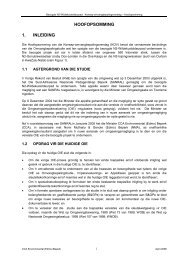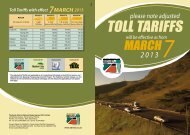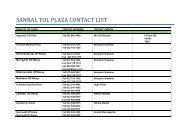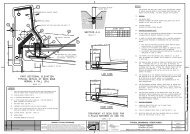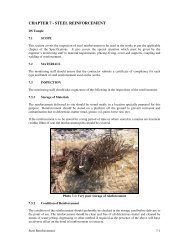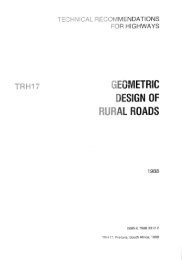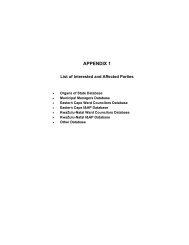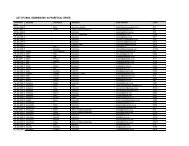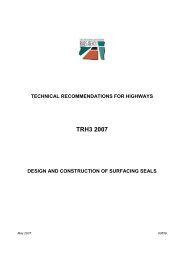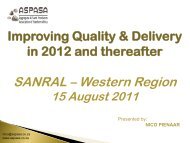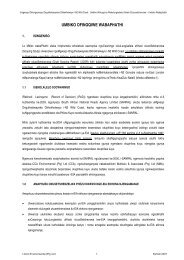SAPEM Chapter 2 - Sanral
SAPEM Chapter 2 - Sanral
SAPEM Chapter 2 - Sanral
You also want an ePaper? Increase the reach of your titles
YUMPU automatically turns print PDFs into web optimized ePapers that Google loves.
South African Pavement Engineering Manual<br />
<strong>Chapter</strong> 2: Pavement Composition and Behaviour<br />
LIST OF TABLES<br />
Table 1. Classification of Pavements Based on Application and Traffic ......................................................... 14<br />
Table 2. Road User Needs, Functional Parameters and Behaviour Measurements ......................................... 22<br />
Table 3. Typical Poisson Ratio Values ....................................................................................................... 30<br />
LIST OF FIGURES<br />
Figure 1. Typical Roman Pavement (McCauley, 1974) ................................................................................... 2<br />
Figure 2. Pavement Structure ..................................................................................................................... 3<br />
Figure 3. Bain’s Kloof Pass .......................................................................................................................... 4<br />
Figure 4. Conceptual Impact of Technological Developments on Roads ........................................................... 4<br />
Figure 5. Impassable Unsurfaced Roads Due to Wet Conditions, Early 20 th Century ......................................... 5<br />
Figure 6. AASHO Road Test (AASHTO, 1961) ............................................................................................... 6<br />
Figure 7. Road Concepts Political and Technical Pyramids for Roads ............................................................... 8<br />
Figure 8. Typical Pavement Structures ....................................................................................................... 10<br />
Figure 9. Example Cross-sections of the Typical Pavement Materials ............................................................ 12<br />
Figure 10. Expected Behaviour of Material Types as a Function of Bitumen and Active Filler Content ................. 13<br />
Figure 11. Classification of Pavement Types based on Materials ..................................................................... 14<br />
Figure 12. Schematic Illustration of Seal Types (a) ....................................................................................... 16<br />
Figure 12. Schematic Illustrations of Seal Types (b) ...................................................................................... 17<br />
Figure 13. Schematic Illustrations of the Types of Rigid Pavements ................................................................ 18<br />
Figure 14. Evolution of Failure Mechanisms with Time and Loading ................................................................ 20<br />
Figure 15. Structural Performance Incorporated into Pavement Condition ....................................................... 21<br />
Figure 16. Pumping of Stabilised Base ......................................................................................................... 22<br />
Figure 17. Surface Cracking and Potholing ................................................................................................... 23<br />
Figure 18. Functional Performance for Different Road Structures ................................................................... 23<br />
Figure 19. Force Applied to an Element of Material ....................................................................................... 24<br />
Figure 20. Normal Stresses ......................................................................................................................... 25<br />
Figure 21. Volume and Shape Changes ........................................................................................................ 25<br />
Figure 22. Principal Stresses ....................................................................................................................... 25<br />
Figure 23. Conceptual Bending Model for a Bound Layer on Unbound Support ................................................ 27<br />
Figure 24. Conceptual Model of Stress-Distribution for Unbound Layer on Unbound Support ............................ 27<br />
Figure 25. Elastic Response to a Load, Sustain, Unload Cycle ........................................................................ 28<br />
Figure 26. Elastic Modulus as a Function of Stress and Strain ........................................................................ 29<br />
Figure 27. Poisson’s Ratio () ..................................................................................................................... 29<br />
Figure 28. Plastic Response to a Load, Sustain, Unload Cycle ........................................................................ 30<br />
Figure 29. Elasto-plastic Behaviour and Resilient Modulus ............................................................................. 31<br />
Figure 30. Viscous Response to a Load, Sustain, Unload Cycle ....................................................................... 32<br />
Figure 31. Thornthwaite’s Moisture Index for Southern Africa ........................................................................ 33<br />
Figure 32. Minimum Asphalt Design Temperature on Surface ........................................................................ 34<br />
Figure 33. Maximum Asphalt Design Temperature at 20 mm Below Surface .................................................... 34<br />
Figure 34. Pavement Deterioration with a Heavy Rehabilitation Strategy ......................................................... 36<br />
Figure 35. Pavement Deterioration with a Frequent Maintenance Strategy ...................................................... 36<br />
Figure 36. Impact of Timeous Maintenance on Life Cycle Costs...................................................................... 37<br />
Preliminary Section<br />
Page vi





